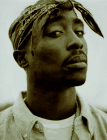|
| |
|
| The Killing of Tupac
Shakur |
|
September 1997
183 Pages
Cathy Scott
Huntington Press
 |
Who did it and why? Tupac Amaru
Shakur was the most popular rapper in the world. No one
symbolized the violence at the heart of gangsta rap more than
Tupac, and he ultimately fell victim to that violence, gunned
down in a drive-by shooting in Las Vegas at age 25. This raw,
no-holds-barred account discloses new information, including
exclusive photo evidence, about the unsolved murder of Tupac:
the failed investigation, the rap wars, the killing of Biggie
Smalls, the Bloods-Crips connection, and the many possible
motives leading to the murder that rocked the music world.
CLICK
HERE TO BUY NOW! |
|
| Tupac Amaru Shakur 1971
- 1996 |
|
September 1997
144 Pages
The Editors of Vibe Magazine
Crown Publishers
 |
"The tragedy of Tupac is that
his untimely passing is representative of too many young black
men in this country....If we had lost Oprah Winfrey at 25, we
would have lost a relatively unknown, local market TV
anchorwoman. If we had lost Malcolm X at 25, we would have
lost a hustler nicknamed Detroit Red. And if I had left the
world at 25, we would have lost a big-band trumpet player and
aspiring composer--just a sliver of my eventual life
potential."
From the Foreword by Quincy Jones
The real story of Tupac's murder may not ever emerge. This may
be the only lasting testament to the many faces of Tupac
Shakur--of a life lived fast and hard, of a man cloaked in
contradictions. A young man who was just starting to come into
his own.
"I believe that everything you do bad comes back to you.
So everything that I do that's bad, I'm going to suffer for
it. But in my heart, I believe what I'm doing is right. So I
feel like I'm going to heaven." Tupac Shakur, June 1996
CLICK
HERE TO BUY NOW! |
|
June 1998
224 Pages
Frank Alexander
St Martins Press
|
September 1997
200 Pages
Armond White
Thunder's Mouth Press
 |
Tupac Shakur has been deified as a
Renaissance man in gansta rap. Paralleling his fame were a
series of court and jail appearances and physical attacks
which ended when he was gunned down on a Las Vegas street. In
this first, full-length biography of the rapper, critic Armond
White attempts to make sense of Shakur's life and death,
examining the larger issues of rap and ghetto culture,
exploitation in the music industry, and the black struggle for
self-expression. Movie rights sold to HBO. 16 photos.
CLICK
HERE TO BUY NOW! |
|
November 1996
Alexander Publishing Group
 |
I was disappointed because this
book was not about Tupac Shakur, but uses the death of Tupac
as a metaphor, for the problems of young black youth in
America. An " I told you so." , documentation, that
I personnally disagreed with, but more importantly, this book
had no facts about Tupac's life, music, upbringing, etc. It
simply used a tragic, sad and hurtful incident, to get it's
own point across and Tupac's name to sell books. If you are a
2Pac fan, you will be very disappointed and waste your money.
If you just wanted to learn more about the rap artist, you
will still be disappointed. Since, there is no information
about Tupac Shakur in this writting |
|
March 1998
288 Pages
 |
No one more epitomized the world
of gangsta rap than Suge Knight, the often brutal CEO of Death
Row Records. Author Ronin Ro shows courage in detailing the
frightening means used by Knight to corner the market on the
most hard-core of urban music. It's a tale that reads like it
was written by the bastard offspring of Horatio Alger and
Quentin Tarantino. Knight's forceful style and legal
entanglements have been the stuff of legend for years. Most
music reporters, coming face to face with the thugs who
enforced the rules at Death Row, have been afraid to tell the
story. With Knight safely behind bars and Death Row in
disrepair, Ronin Ro finally has the chance to put this violent
soap opera in print.
CLICK
HERE TO BUY NOW! |
|

|
|